Log cabins and panel buildings, erected several decades ago, to this day have a completely worn-out base or what is left of it. If the wooden building itself stands still for some time, then the foundation or crowns must be urgently replaced. This operation requires lifting the house.
- How to prepare a wooden house for lifting
- What houses can be lifted and why?
- Jack selection
- The process of lifting a house with your own hands step by step
- Preparation, disconnection of communications
- Jack installation
- House lifting technology
- Dismantling the old base and installing a new one
- The main mistakes of lifting a house with a jack
How to prepare a wooden house for lifting
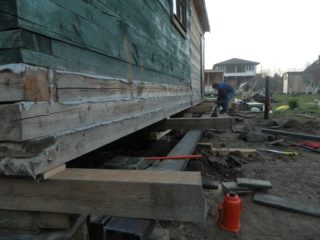
For the competent raising of the house, it is necessary to comply with several conditions for the preparation of the structure:
- remove all furniture and plumbing equipment from the house;
- dismantle doors, window frames;
- to reduce the weight of the structure as much as possible by partial disassembly of floors, floors, partitions;
- if possible, dismantle the roof of the building;
- inspect the building for loose or rotten logs.
Weakened structures are reinforced by diagonal planking with bolts. This will allow the building to stand and not deform.
What houses can be lifted and why?
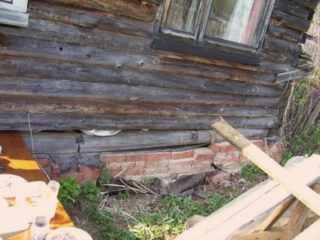
A feature of the operation of wooden log structures, country houses from a bar is the periodic repair of the lower part of the building. The lower crowns fail and rot during many years of operation. Periodic replacement of the front rows is useful for hardwood buildings. Oak, larch can stand for centuries and only a rotten base will threaten to collapse.
Jacking up is also a prerequisite for replacing a worn-out foundation, moving a wooden building, and installing it on piles.
With a jack for repairs, it is allowed to lift only one-story buildings made of logs, beams or frame structures.
It is recommended to replace the lower rims in 15-20 year increments. Modern buildings are more susceptible to rotting due to poor ecology and insufficient forest preparation during construction.
Jack selection
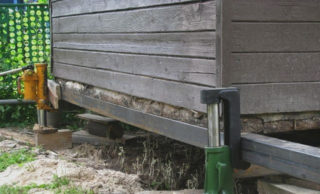
When choosing a jack, it is necessary to correctly calculate the weight of the house. The result obtained is divided by 4. When lifting a small house, it is necessary to have a reserve of half the mass. On small structures, only 4 lifting mechanisms are exhibited at the corners. They are installed under large ones more often.
After calculating the masses, they are determined with the type of mechanism, which is suitable for the designated purposes. A jack for lifting a wooden house at a short distance from the installation point to the crown must be inflatable or movable. With a distance from the lifting point to the ground more than 30 cm, bottle, scissor hydraulic lifts are suitable.
The calculation of the building's weight is based on the weight of a worn-out rounded log - 700-800 kg / m³. The volume is calculated in m³. It includes all walls, ceilings, partitions. The weight of all not carried out property is added.
The process of lifting a house with your own hands step by step
The work depends on the weight and the number of lifting points. At a minimum, it is enough to use one jack to raise the house. But this rule only works for small buildings. When using one lift, the vertical offset of the corners is uneven.Therefore, the decoration of the house may become unusable. Possible misalignment of doors, window frames.
The use of two lifting mechanisms allows synchronizing the lifting of the structure on one side and preventing serious deformation.
For the simultaneous lifting of the walls, at least 4 devices are used, and if the walls are long, then more. In this case, a small deformation of the building is guaranteed. After work, it will not require major repairs.
Preparation, disconnection of communications
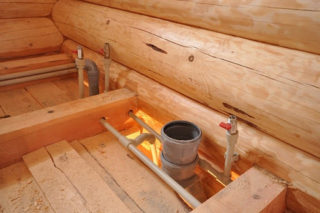
Before starting work on the rise, it is necessary to turn off all communications - electricity, water supply, sewerage, Internet cables, gas supply. Underground communications are disconnected or cut. Failure to do so may interfere with lifting or cause damage to the building.
If there is a stove in the house, the free movement of the pipe through the ceilings, the roof is ensured. If its foundation is autonomous, that's enough. If the boiler is located on the floor of the building, it must be turned off, remove all piping and pipes. In a wall-mounted version, the boiler will not interfere.
Jack installation
The installation method depends on the type of foundation. In slab or tape, rectangular niches are cut for rolling. Columnar or pile piles require wooden board gaskets. The installation site must be smooth and level. It is equipped with a three-legged stand for height adjustment. For the linings, you will need wooden plates with a width of at least 20 cm.
The correct installation of the jack depends on the condition of the log house:
- If the lower rims are rotten, it is necessary to cut holes in them up to a whole log, against which the head of the lift rests.
- If the crown is intact, a niche in the old foundation will be required to install the foundation. A metal plate or a piece of channel is installed under the jack to distribute the bearing load.
When performing work, pay attention to the verticality of the jack rod. When it is skewed, the work stops, and the lifting mechanism is leveled. The lack of verticality of the jack threatens the house sliding or falling. In any case, a metal plate with a size of at least 10 * 10 cm is placed under the jack head to prevent the tree from being pushed through.
House lifting technology
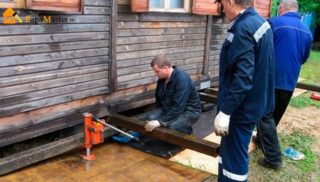
The step-by-step method of jacking up includes preparatory work and the following operations:
- Determine the number of jacks, lifting scheme.
- Level, compact the soil in the places where the lifts are installed.
- The support area under the mechanism must be increased.
- Make a reference plane at the point of contact between the jack and the tree. Cut the decayed tree to a hard surface. When replacing the lower rims, it is necessary to saw down above the rows to be replaced.
- The lifting of the supports must be carried out evenly, no more than 2-4 cm per cycle.
- As work progresses, it is required to install fixing gaskets, powerful stops to prevent uncontrolled breakdown of the building from the jacks.
- Constantly monitor the position of the house, its horizontal, vertical movement.
When performing work, you must pay attention to the following points:
- With a flimsy building structure, it is imperative to strengthen it with thick boards.
- To prevent deformation, window and door openings are reinforced with spacers.
- It is necessary to check the strength of the wood in the places where the rods are installed.
- In the places of contact, the location of steel thrust bearings or thick boards from 50 to 100 mm is required.
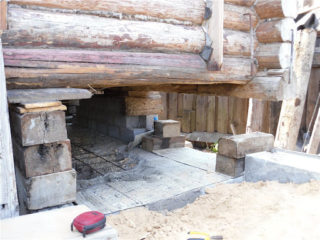
Depending on the number of lifts, the lifting scheme will change:
- When using one jack, it is alternately rearranged under the corners of the building with a vertical movement of points no more than 5 cm. This will avoid loosening the structure, irreversible deformations of window and door openings.The raised area is securely fixed with stops, and the device is transferred to another area. This is how the house rises in turn to the desired level.
- When using two lifting mechanisms, they are located on one side of the building and are lifted synchronously. This allows you to reduce the skew of the structure. The lifting algorithm is similar to using a single lift.
- Synchronous operation of 4 or more devices allows you to raise the building quickly, as efficiently and safely as possible. Alternating lifting for 1 cycle - no more than 2-4 cm. For synchronization, use voice communication or professional equipment with synchronous lifting.
To control the lifting height, special measuring rods are installed at the corners. It is forbidden to measure the lift height by tracking the extension of the rod, since the lift sags under load, and the wall material is pressed in during deformation.
With this method, the house rises to a height of 10 to 50 cm, which is quite enough to replace the foundation or crown of the house.
Dismantling the old base and installing a new one
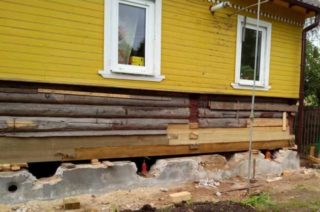
After raising the old house, it is sometimes necessary to replace not only the crowns, but also the foundation. The old frame is disassembled using a jackhammer, puncher, crowbar, sledgehammer. To dismantle a powerful foundation, construction equipment will be required. The waste generated by lifting the house and replacing the foundation is left. They come in handy when pouring a new base.
Features of dismantling different types of foundations:
- Dismantling the belt begins with an assessment of the complexity and scope of work. A small one can be disassembled with an improvised tool. For fittings, use a grinder. Large structures require special mechanisms and equipment.
- Dismantling the precast concrete base is not particularly difficult. The joint seams between the blocks are broken off with a jackhammer. The mounting hinges are brought to a vertical position. With the help of construction equipment, the FBS blocks are pulled out, loaded onto a car, and taken away. Reinforced concrete blocks are a durable material. It is possible to reuse them at less critical facilities.
- At the destroyed pile foundation, the top is chopped off. If severely damaged, re-installation will be required.
- The monolithic slab collapses in the same way as the strip base. If necessary, part of the base is used or built up with a change in area.
- Other types of bases - rubble, columnar, are disassembled with improvised tools using a grinder, a jackhammer, a sledgehammer.
- The destroyed screw foundation is cut to a single part and extended with a metal pipe.
Naturally, dismantling work is the most laborious. They require a responsible decision and adherence to safety standards.
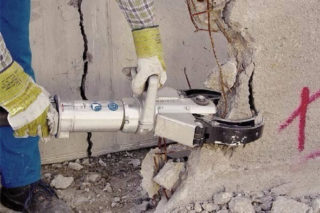
Methods for destroying the base:
- hand tool;
- excavator, heavy equipment;
- chemicals;
- explosion;
- ultrasound;
- hydrocline.
In private housing construction, the first 2 methods are more often used. When dismantling, the main thing is to correctly calculate your strength. In some cases, hiring a professional team is more profitable than doing it yourself.
Stages of installing a new foundation:
- After removing the foundation, a trench is formed for a new support. When the old foundation is deeply buried, the sand cushion is renewed - it is poured, spilled with water, rammed. In the case of shallow laying, the trench is deepened by 20 cm and a shock-absorbing cushion is also poured in.
- Removable or non-removable formwork is installed in the trench. The jacking points are bypassed. Subsequently, the technological holes are laid with bricks.
- Waterproofing and a reinforcing belt are placed in the formwork. The lattice in it is welded or knitted with wire. The edges of the reinforcement must be at least 50 mm apart from the outer layer of the foundation to prevent premature corrosion.
- In the corners, the reinforcement cage should be bent, not welded.These are the most tense parts of the foundation.
- The prepared formwork is poured with concrete in 1 time or at least 1 shift.
- After the concrete has set, the logs are replaced. The method of tapping is used to identify rotten areas and cut them down. The logs are replaced up to the well-preserved ones.
When installing, be sure to use hydro, thermal insulation. This will prolong the life of the walls, foundation. With good care, the blockhouse will stand for another 30-40 years before being repaired.
The main mistakes of lifting a house with a jack
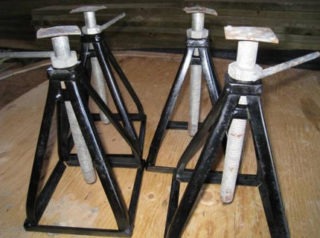
When lifting a house with a jack, it is important not to violate the technology and do everything according to the instructions. In order to avoid partial or complete destruction of the building, a certain technology must be followed.
- The lifting capacity of the jack must be greater than the total mass of the building.
- Whenever possible, use of 4 or more lifting devices is provided.
- The house needs to be lifted evenly. Misalignment leads to loss of stability and rollover.
- Supplied supports must be able to support the weight of the building with a margin.
- The bases for the jacks must be stable.
The rise of brick, monolithic or panel houses is carried out using a different technology. A complex metal structure is formed above the foundation, and the building is shifted by hydraulics. It is impossible to carry out such work on your own.









Jack then why? Why didn't they ask the builders?
For me it is better to demolish and build a new one, it will be cheaper and already as you need.
I had to do this work near Leningrad. The log house was on the so-called. bonfires are already in the design position, it was necessary to lay the foundation under it.
I changed the foundation for a log house alone in 20 years. Here they complicate everything. Raised one corner quite a bit, put it under the wall, where the lower crown lies on the replaced one. Jack at a different angle. He also raised the log a little, rolled it out. I arranged the foundation on this side, lowered it onto the substrate, moved to another corner or to the opposite wall - what will you change. I personally let down the brick foundation instead of the remote crowns. They did not take anything out and did not disassemble anything. House with five walls. And he spied on another house, the old man was changing. He also did not strengthen anything and could not stand it. And they didn't do anything with the stove. Of course, the question is whether to change the residents of Tomvians or even raise them. In the first case, everything is quite simple.
There were once rack jacks of 5 and 10 tons.
Have they stopped producing them?
Alexey is right, everything is much easier. Even as a child, I saw many times how log houses are understood, and I myself had a chance to raise four houses in my life to lay new foundations. At the same time, he always worked alone. Calculations of the power of the jacks are superfluous, in most cases there are enough five-ton trucks, but 12-16-ton trucks are better - it is easier to work with them and will not fail due to overload. When lifting at angles, place 2 jacks, one under each wall, because It is very difficult to lift two walls at once by one and the jack may not withstand. The main danger of skewing the jack, if it is hydraulic, is that due to the elasticity of the oil, it can fly out and kill. There are cases, he himself once miraculously survived. The complete destruction of the old concrete strip foundation in the absolute majority is not necessary, at most, repairs. In 70 years of my life, I have never heard that during the repair and leveling of log houses it is necessary to break a solid concrete foundation. Moreover, if it is available, the blockhouse can be raised without jacks at all, using wooden wedges made of hard rock: first, a number of thin (up to 50 mm) wedges are hammered between the concrete or brick foundation and the lower crown, then thicker wedges between them (and thin ones are removed) , then even thicker ones - until the desired result.I leveled one of the houses. It is important to lay a roofing material between the mineral foundation and the lower crown, anyway from the sweating of the foundation, the tree did not get damp and did not rot. Placing boards of the dimensions indicated by the author of the article under the jacks can only help when lifting light frame-board and very small country houses, and even then not on all soils. In the case of log cabins, such boards, and even channels, break, bend, and sink into the ground. The guaranteed options are the jack stop either in the old concrete (brick) foundation, or preliminary pouring a special concrete slab under it, sometimes even 1x1x0.2 m, if the soil is swampy. Or it is necessary to abut against the support slabs specially made from 2 layers of a wooden beam having a thickness of 100x100 mm, and the dimensions of such a slab should be no less than 600x600 mm. I also learned for the first time that it was necessary to take out furniture (and why not icons?) And expose windows. This is one of the newest discoveries. Nano-tech, I suppose. I have never seen anything like this in my life. He himself once lifted the house, allowing very large temporary distortions of the entire structure, while not a single window glass burst, not to mention the breakage of window frames, and even more so the windows. Further, the correctness of hanging the raised log house is elementary checked by a bubble level: a long flat rail is placed on the floor of the house, a level is placed on it, and then the rail is placed in the perpendicular direction and in the diagonal. If deviations in height are found, they are removed by jacking up. The jacks shown in the photo on four-legged bases are not suitable for raising log cabins, firstly, because of their height, it is difficult to bring them under the wall, and secondly, with a powerful stock, they have weak legs that will not support the weight of the log house. I have similar aircraft jacks, their capacity is only 1.5 tons. They are suitable only when replacing the upper rims of a log house, or when exposing the upper parts of walls made of bricks or blocks. To do this, they are placed on the floor of the room, and through an intermediary from a two-inch drill pipe, they abut against the supporting ceiling beams, then raising the entire roofing system above the walls.
Are there any instructions on how to move the bathhouse to another place? Bath from a bar.